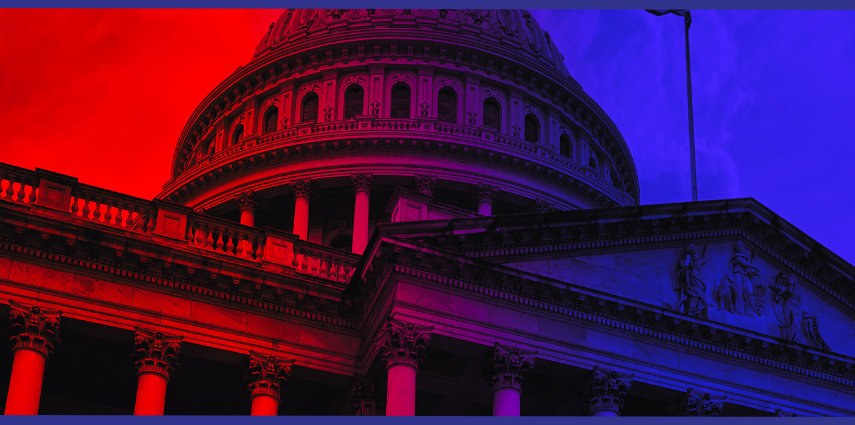The 2024 political season is gearing up to be one of the most significant in terms of advertising spend. With estimates suggesting a 30% increase in spending compared to the 2020 election, B2B marketers must navigate this turbulent landscape with strategic precision. While B2B marketers might often feel like our audience are unique to us, it’s important to keep in mind that we share our audiences with B2C advertisers and politicians. We’re sharing targets with other advertisers B2B and B2C and political, so that needs to be considered. Here’s what you need to know to stay ahead of the curve and ensure your digital advertising campaigns remain effective.
The Surge in Political Ad Spending
Political ad spending in 2024 is estimated to hit $12.3 billion. Traditional media, especially TV, will be the primary beneficiary, with 72% of the budget allocated to these channels. However, digital media is also expected to see a considerable spike, with spending on platforms like Meta and Google growing by over 150% compared to the 2020 election. Despite this growth, digital media will still only account for about 10% of the total ad spend.
This surge in spending will have significant implications for all advertisers, including those in the B2B space. The equal-time rule mandates that political candidates must have the ability to advertise and possess first rights over any brand in the market. This regulation ensures that political ads will dominate the available inventory, leading to higher competition and costs for other advertisers.
Early Predictions and Market Impact
One of the critical predictions for this election cycle is that political ad spending will begin earlier than in previous years, starting in late August and early September. This early start will create a scarcity of inventory, leading to several challenges for non-political advertisers:
- Increased CPMs: The cost per thousand impressions (CPM) is expected to rise significantly due to heightened competition for ad space.
- Unavailable Inventory: The limited inventory will be quickly claimed, leaving less room for non-political ads.
Channels predicted to be most affected include Linear TV, OTT/CTV, YouTube, and Meta. Political ads will saturate these channels, accompanied by extensive political commentary. As the election approaches, the intensity of ad spending will escalate, peaking just before November 5th and dropping off significantly afterward.
B2B Brand Considerations and Strategic Adjustments
For B2B marketers, navigating this period requires careful planning and strategic adjustments. Here are key considerations to keep in mind:
Brand Safety and Ad Placement
Many brands prefer to remain neutral in the political landscape, avoiding any association with political ads or commentary. It’s crucial to evaluate your brands’ comfort level of ads being displayed alongside political content. If your brand is uncomfortable, consider these strategies:
- Alternative Inventory: Consider front-loading spend to July and August to avoid the peak political ad period.
- Shifting Budgets: Explore shifting advertising budgets to platforms like Google Search and LinkedIn, which offer a safer environment. However, be aware that LinkedIn’s OTT/CTV product might also face inventory constraints.
- Blocking Tools: Utilize tools like IAS to block news-oriented or political content, as well as news networks and sites on the display side.
Budget and Spend Management
With the holiday season following the election, most B2B brands experience a slowdown in advertising activities. Retail advertisers, on the other hand, are likely to hold their budgets until after the election, then ramp up spending for the holidays. This dynamic creates an opportunity for B2B marketers to adjust their strategies:
- Early 2025 Budgets: Consider preserving or shifting budgets into early 2025 to avoid the competitive landscape of the political season.
- Creative Investments: If the budget needs to be spent within the current fiscal period, invest in creative assets that can be leveraged post-election.
Adapting to the New Advertising Environment
The 2024 political season is poised to create a challenging advertising environment, but with strategic foresight and flexibility, B2B marketers can navigate these obstacles effectively. Here are some additional tips to help you adapt:
- Monitor Political Ad Schedules: Keep a close eye on political ad spending schedules and trends to anticipate peaks and adjust your campaigns accordingly.
- Flexible Media Plans: Partner with your agency to build flexible media plans that can be quickly adjusted based on inventory availability and cost fluctuations.
- Communication: Maintain open communication with your agency, and ensure they are setting realistic expectations about potential challenges and the need for adaptable strategies.
- Test New Channels: Experiment with less saturated channels and innovative formats to reach your audience without directly competing with political ads.
By staying informed and proactive, B2B marketers can mitigate the impact of the 2024 political ad surge and continue to achieve their advertising objectives. The key lies in understanding the market dynamics, planning ahead, and being ready to pivot as needed.



